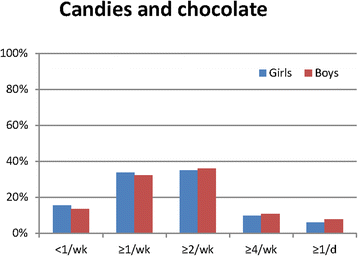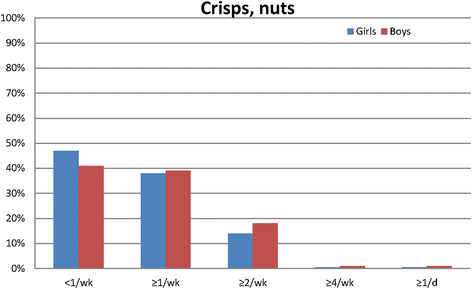Dietary intake, leisure time activities and obesity among adolescents in Western Sweden: a cross-sectional study
- PMID: 27103118
- PMCID: PMC4840851
- DOI: 10.1186/s12937-016-0160-2
Dietary intake, leisure time activities and obesity among adolescents in Western Sweden: a cross-sectional study
Abstract
Background: Overweight and obesity among adolescents are increasing worldwide. Risk factors include dietary intake characteristics and high levels of physical inactivity. In Sweden, few large comprehensive population-based surveys of dietary intake and lifestyle among adolescents have been carried out. Thus, the purpose of the current study was to describe dietary intake and food choices as well as leisure time activities in relation to overweight and obesity in a total sample of all schoolchildren aged 15 years in Western Sweden.
Methods: In 2008, a questionnaire was sent to all 21,651 adolescents born in 1992 in Västra Götaland Region, Sweden. Participation rate was 54.3 % (50.7 % girls/49.3 % boys). The questionnaire included a 73-item semi-quantitative food frequency questionnaire and questions on lifestyle. Results were evaluated against the Nordic Nutrition Recommendations and Swedish indicators of healthy diet and exercise habits. Associations with concurrent overweight and obesity were evaluated in multiple linear regression analysis.
Results: Among girls, 49.5 % reached the goal of consuming fruit and vegetables at least daily, whereas for boys the figure was 34.4 %. Among both sexes, 15 % reached the goal of consuming fish at least twice weekly. Two-thirds of both sexes reached the goal of regular moderate or vigorous physical activity weekly. In total, 12.4 % were overweight and 2.4 % were obese. More girls than boys were underweight, whereas more boys than girls were overweight or obese (p < 0.001). Boys exhibited a more frequent intake of sodas and concentrated fruit juices, milk 3 % fat, bread and potatoes and fast food (p < 0.001). Frequent intake of candies and chocolate was reported by both sexes. Among girls and boys, living in rural areas, living in apartments and reporting no frequent leisure time physical activity were significant risk factors for being overweight or obese, also when adjusted for other risk factors.
Conclusions: Dietary habits of adolescents in Western Sweden warrant improvements. Public health actions should be taken to increase consumption of fruit, vegetables and fish, and decrease consumption of sodas and candies and also to increase frequency of physical activity. These actions may be helpful in reducing risks for overweight and obesity.
Keywords: Adolescents; Cross-sectional study; Diet; Obesity; Physical activity; Sweden.
Figures



Similar articles
-
Relative contribution of physical activity, sedentary behaviors, and dietary habits to the prevalence of obesity among Kuwaiti adolescents.Food Nutr Bull. 2013 Mar;34(1):6-13. doi: 10.1177/156482651303400102. Food Nutr Bull. 2013. PMID: 23767276
-
Physical activity, sedentary behaviors and dietary habits among Saudi adolescents relative to age, gender and region.Int J Behav Nutr Phys Act. 2011 Dec 21;8:140. doi: 10.1186/1479-5868-8-140. Int J Behav Nutr Phys Act. 2011. PMID: 22188825 Free PMC article.
-
Food intake, leisure time activities and the prevalence of obesity in schoolchildren in Slovakia.Cent Eur J Public Health. 2010 Dec;18(4):192-7. doi: 10.21101/cejph.a3607. Cent Eur J Public Health. 2010. PMID: 21361101
-
[Simple obesity in children. A study on the role of nutritional factors].Med Wieku Rozwoj. 2006 Jan-Mar;10(1):3-191. Med Wieku Rozwoj. 2006. PMID: 16733288 Review. Polish.
-
Nutrition and lifestyle in european adolescents: the HELENA (Healthy Lifestyle in Europe by Nutrition in Adolescence) study.Adv Nutr. 2014 Sep;5(5):615S-623S. doi: 10.3945/an.113.005678. Adv Nutr. 2014. PMID: 25469407 Free PMC article. Review.
Cited by
-
Overnutrition and Associated Factors Among High School Adolescents in Mid COVID-19 Pandemic in Ethiopia: Neglected Public Health Concern.Adolesc Health Med Ther. 2022 Jan 19;13:1-14. doi: 10.2147/AHMT.S349189. eCollection 2022. Adolesc Health Med Ther. 2022. PMID: 35082546 Free PMC article.
-
Association of white and red meat consumption with general and abdominal obesity: a cross-sectional study among a population of Iranian military families in 2016.Eat Weight Disord. 2017 Dec;22(4):717-724. doi: 10.1007/s40519-017-0385-x. Epub 2017 Apr 18. Eat Weight Disord. 2017. PMID: 28421475
-
Five years' follow-up of dental fear and anxiety, experience of dental care and oral health behaviour in Swedish preterm and full-term adolescents.BMC Oral Health. 2017 Dec 4;17(1):145. doi: 10.1186/s12903-017-0431-0. BMC Oral Health. 2017. PMID: 29202809 Free PMC article.
-
Clustering of Lifestyle Risk Factors among Algerian Adolescents: Comparison between Urban and Rural Areas: GSHS Data.Int J Environ Res Public Health. 2021 Jul 2;18(13):7072. doi: 10.3390/ijerph18137072. Int J Environ Res Public Health. 2021. PMID: 34281010 Free PMC article.
-
Adolescents' diet quality in relation to their relatives' and peers' diet engagement and encouragement: the Healthy Lifestyle in Europe by Nutrition in Adolescence (HELENA) study.Public Health Nutr. 2018 Dec;21(17):3192-3201. doi: 10.1017/S1368980018001787. Epub 2018 Aug 10. Public Health Nutr. 2018. PMID: 30095062 Free PMC article.
References
-
- Kohn M, Booth M. The worldwide epidemic of obesity in adolescents. Adolesc Med. 2003;14:1–9. - PubMed
-
- World Health Organization. The challenge of obesity in the WHO European Region and the strategies for response. Branca F, Nikogosian H, Lobstein T, editors. Denmark: World Health Organization; 2007.
MeSH terms
LinkOut - more resources
Full Text Sources
Other Literature Sources
Medical

